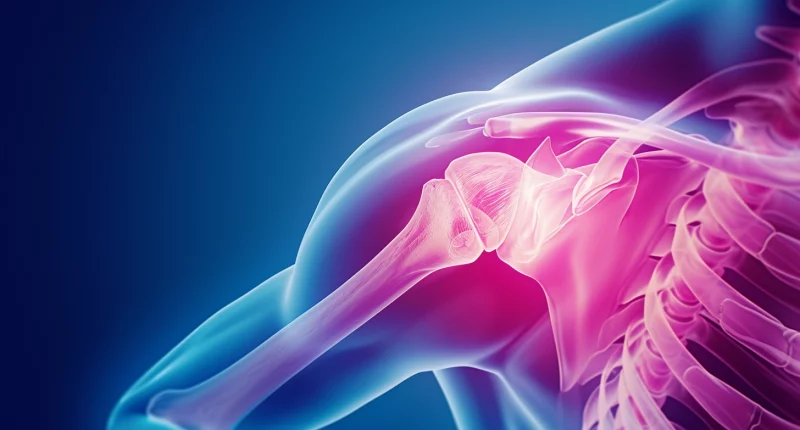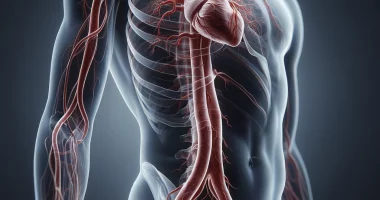Recurrent shoulder dislocation
What’s that?
Recurrent shoulder dislocation is a condition in which the articular surfaces repeatedly change their physiologic position after an episode of acute dislocation.
About the disease
Traumatic dislocation most often occurs when the injury is sustained with the arm being abducted. The incidence of recurrence and chronic dislocation in the first two years after acute trauma ranges from 35 to 85%, especially in the young and most able-bodied.
All patients with suspected chronic shoulder dislocation undergo X-ray scanning in specific planes (true anteroposterior, West Point, and Stryker). Computed tomography or nuclear magnetic study of the shoulder joint can be performed to detail the pathological process. Examination of the articular structures from the inside is performed by diagnostic arthroscopy.
According to the modern concepts of traumatology and orthopedics, surgery is the only justified method of treating recurrent shoulder dislocation. Minimally invasive arthroscopic interventions have replaced open surgical interventions. However, to achieve the best therapeutic results and reduce the risk of undesirable consequences, a differentiated approach to the choice of surgical technique is required.
Types
The primary morphologic forms of recurrent shoulder dislocation include:
- Bankart’s injury – due to an anteroposterior dislocation of the bone, the cartilaginous labrum with attached ligamentous compartment is torn away.
- Perthes injury – when dislocated, the humeral head peels off the capsule-chondral complex along with the periosteal flap of the anterior surface of the humeral neck.
- Bankart’s bone injury is a marginal fracture of the anterolateral edge of the scapula, which is involved in forming the articular scapula joint. This injury is also accompanied by a decrease in the tonus of the corresponding parts of the capsule-ligamentous complex attached to it.
- HAGL is an injury in which the joint capsule is detached from the humeral head, but the capsular-cartilaginous complex of the articular cavity is intact.
- Hill-Sachs lesion is a depression fracture of the posterior superior margin of the humeral head in contact with the anterior margin of the articular cavity due to anteroposterior head displacement during dislocation. Hill-Sachs depression defect is quite common in traumatic dislocations, but it is extremely rare to be large and, without damage to the anterior capsule, does not usually lead to instability. It develops only in the presence of significant defects in the articular surface of the humeral head, not only in the area but also in depth, when the defect area extends beyond the anterior edge of the joint cavity during the physiologic range of motion.
Symptoms
Limitations of mobility in the joint characterize recurrent shoulder dislocation. That is mainly due to the reflexive protective contraction of the para-articular muscles, which are in an abductive position and external rotation.
The main symptoms of recurrent shoulder dislocation are:
- a change of the shape of the joint;
- disruption of its functional condition;
- elastic resistance in the joint;
- Low-intensity painful sensations that may increase with exertion;
- forced arm position – the person usually supports the painful limb.
Causes of recurrent shoulder dislocation
The direct cause of recurrent dislocation of the shoulder is a previous acute trauma to the right or left joint, which disrupts the congruence of the articular surfaces. The character of the shoulder structure predisposes to the fact that there is an increased risk of repeated dislocation of the humeral head from the articular cavity. For example, the risk of recurrent dislocation increases if the capsular ligamentous compartment, which eventually stretches the capsule, is damaged. The risks also increase with muscle imbalances of the internal and external rotators, defects of the articular lip, and disruption of the integrity of the bone in forming the articular surface.
Diagnosis of recurrent shoulder dislocation
Diagnosis of a recurrent shoulder dislocation usually involves a personalized set of the following procedures:
- Standard two-projection radiographs of the shoulder joint are mandatory in the preoperative evaluation of patients with recurrent shoulder dislocation. It is always advisable to have an archival radiograph performed before the dislocation is repositioned. It dramatically facilitates diagnostic assessment of recurrent dislocation with a vague clinical picture and allows us to determine the direction of dislocation: anteriorly or posteriorly reliably. In addition, X-ray examination aims to detect bone defects of the humeral head or the articular cavity of the scapula, which may cause recurrent instability. Velpeau view is used to diagnose cavity defects, and a defect in the posterior pole of the humeral head (Hill-Sachs lesion) is identified on a Stryker radiograph.
- Computed tomography (CT) is much more significant than radiography, with opportunities for diagnosis and accurate determination of the size of bone defects in the joint area. However, in the decision to perform this study, the doctor considered radiation exposure several dozen times higher than radiation exposure during banal radiography.
- Ultrasound scanning of the joint. Ultrasound can also detect depression fractures of the humeral head and assess their depth and extent. At the same time, verification of injuries of the capsular-cartilage complex of the shoulder joint by ultrasound scanning is difficult due to the presence of artifacts.
- Magnetic resonance imaging (MRI) is the gold standard for visualizing soft tissue injuries. It detects with high reliability the leading and most common causes of recurrent dislocation, such as damage to the capsule, ligaments, and cartilaginous lip.
Treatment of chronic shoulder dislocation
According to clinical guidelines, surgery is the generally accepted treatment method for recurrent shoulder dislocation. Doctors also differ in their approach to determining the timing of surgical treatment, considering the patient’s age and the number of recurrences. Currently, two surgical stabilization methods are commonly used to treat recurrent shoulder dislocation: Bankart reconstruction and Latarjet-Bristow surgery.
Conservative treatment
The conservative method of treatment does not get rid of the recurrent dislocation. This method can only be used temporarily when surgery needs to be postponed.
A conservative approach includes:
- physical therapy (weight-bearing exercises);
- stimulation of the muscles of the rotator cuff with electric current;
- massage;
- physiotherapy procedures that improve metabolic processes and microcirculation in soft tissues.
Surgical treatment
The main types of surgery for recurrent shoulder dislocation are:
- Arthroscopic reconstruction for instability, or Bankart reconstruction. Surgery may not be effective if there is a defect in the bone structures, such as a Hill-Sachs lesion or a defect in the articular cavity of the scapula.
- In the presence of the above-mentioned bone defect, the operation is performed to replace it using transposition of the clavicular process (Latarjet-Bristow operation). This surgical intervention is very successful (recurrence rate less than 4%), which consists of increasing the area of contact between the articular surfaces of the head of the humerus and the articular cavity of the scapula, creating additional stabilization in shoulder deviation and external rotation due to the tendon of the clavicular-shoulder muscle; and restoring the joint capsule.
All these treatment options are available in more than 790 hospitals worldwide (https://doctor.global/results/diseases/recurrent-shoulder-dislocation). For example, Bankart shoulder repair surgery is performed in 29 clinics across Turkey for an approximate price of $4.7 K (https://doctor.global/results/asia/turkey/all-cities/all-specializations/procedures/bankart-shoulder-repair-surgery ).
Prevention
The most reliable way to prevent recurrent shoulder dislocation is atraumatic repositioning of the primary dislocation with adequate anesthesia and immobilization for at least three weeks. The classic immobilization method after a closed dislocation is the internal rotation position in a Dezo arm support.
Rehabilitation for recurrent shoulder dislocation
Rehabilitation for recurrent shoulder dislocation is carried out after surgical intervention. It may include physical therapy, physiotherapy, massage, and taping.




